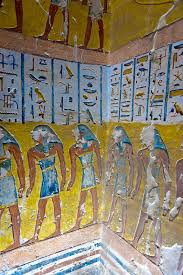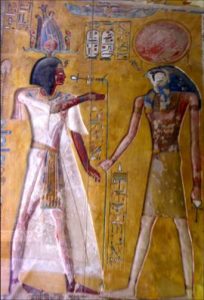
Pharaoh Siptah (Mer-en-ptah), who's name means "Son of Ptah, Beloved of Ptah", was the son of King Seti II. He ruled the country with his stepmother Tausret as a regent. The history of the Tomb of Siptah which measures 125 meters long is confusing. At the end of the Ninth Dynasty, after Siptah's burial, the King's cartouches were erased, then later restored in blue paint. The tomb was re-used in the Third Intermediate Period. Some excavations were made in 1905, 1912, and 1916, but they were thwarted because poor quality bedrock posed structural problems. Recently some excavations have been attempted.
- Corridors B, C, and D of the Tomb of Siptah
Corridor B of the Tomb of Siptah (KV 47): Measuring 15 meters long, Corridor B of KV 47 begins with a gate, the lintel of which has paintings of a solar disc representing god Re-Horakhty flanked by goddess Ma'at (goddess of justice) seated on a basket. Beautifully painted texts and scenes decorate the walls of the corridor. On the left wall, at its beginning, the king stands with god Re-Horakhty, and their figures are painted against a yellow background. The remainder of the wall has a white background. First, we have the opening scene of the Litany of Ra, and then the text of the Litany, which continues on the right wall. Corridor C: In this corridor, the visitor can see the Litany of Ra depicted on both sides, with seventy-four figures which are the manifestations of the solar deity. At the end of each wall, on the top, there are scenes from Chapter 151 of the Book of the Dead. A figure for Anubis stands beside a mummy lying on a bed with lion's heads and paws. Above, the Anubis jackal is flanked by figures of Isis and Nephthys (Isis' sister). Corridor D: Most of the walls of this corridor were originally decorated with scenes and texts from the fourth and fifth hours of the Imydwat, but now all of the decoration in this chamber has gone. A very finely drawn hull, in red and black, stands with its head lowered as if preparing to charge, it is located at the top of the column on the right thickness of the gate leading into Chamber E.
- Chamber E, F, and the Burial Chamber of the Tomb of Siptah

Mostly, there is no preserved decoration in the Tomb of Siptah (Mer-en-ptah). The stone of the tomb is of poor quality, and the lighting that has been recently installed is dim. Moving to Chamber F which is a pillared chamber, we can find traces of red ink in the middle of the right wall outlining what was intended to be a gate to a side chamber. In the short corridor, before the Burial Chamber, there is a small side passage, perhaps intended to lead into a side chamber or to be a part of Burial Chamber. The Burial Chamber of KV 47 still houses the red granite sarcophagus of Siptah. The mummy of Siptah, which shows that the King had suffered from poliomyelitis or clubfoot, was found in the cache of mummies in 1898 in the Tomb of Amenhotep II (KV 35).
